Special Interview_Meeting people, Learning societal needs, and Arranging new “Chemical Reactions”
<Interviewee>
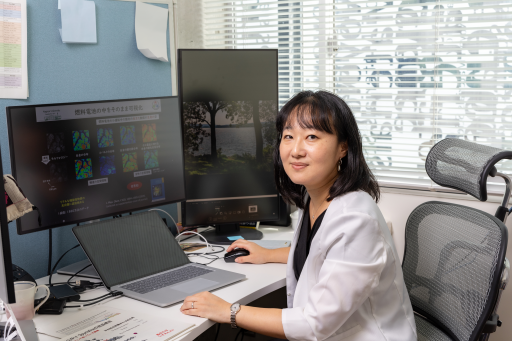
Mizuki TADA (Ph.D.)
Professor, Laboratory of Inorganic Chemistry, Research Center for Materials Science / Graduate School of Science, Nagoya University
—
Studying the solid catalysts of inorganic materials, Dr. Tada works on both the synthesis of new catalysts and the visualization of active catalyst structures and catalysis. She organizes various collaborative researches with industry such as fuel cell for automobiles and rubber tire.
—
● Addressing longstanding challenges in catalyst research
“Many catalysts have been used in modern society, but solid catalysts are complicated. It is quite difficult to understand the structures of active species in real catalysis.”
For examples, diamond has a crystalline structure in which carbon atoms are orderly arranged in a particular pattern. In contrast, the structures of solid catalysts that Dr. Tada studies are complicated and heterogeneous. A solid catalyst is composed of particles, whose sizes and structures are heterogeneous, and they are attached on a support material. However, this heterogeneity is essential in real catalysis. How do they work? Where do catalytically active sites locate? To understand them on a fundamental level, it is necessary to utilize not only synthetic approach but also techniques to “visualize” working catalysts.
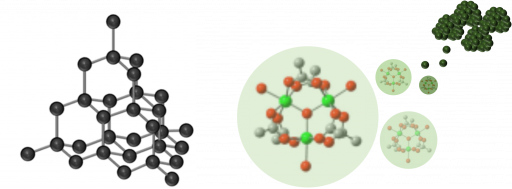
(Left) The crystal structure of diamond.
(Right) An image of a Ru3 complex precursor and a Ru cluster catalyst prepared from the precursor. There are various Ru clusters in a variety of sizes and shapes, and they are dispersed on the surface of a solid oxide support. (Dispersed Ru nanoclusters transformed from a grafted trinuclear Ru complex on SiO2 for selective alcohol oxidation, S. Muratsugu, M. H. Lim, T. Itoh, W. Thumrongpatanaraks, M. Kondo, S. Masaoka, T. S. A. Hor, and M. Tada, Dalton Trans., 42, 12611-12619 (2013))
There are various approaches in studies on catalysts and catalysis, and various knowledge and skills have been required, such as the synthesis of new materials, the developments of reaction processes. In general, catalysts are prepared by the huge repetition of synthetic trial-and-errors and catalyst tests. The details of their active structures and catalysis are often found afterwards. Most of present catalysts currently used are still black box without understanding their catalysis.
The laboratory Dr. Tada belonged when she started her research activities focused on the developments of new physicochemical methods for catalysis researches, and developed measurement techniques to identify the local structures of solid catalysts, called X-ray Absorption Fine Structure (XAFS). This method uses high-energy hard X-rays and the transmission and absorption behaviors of X-rays depend on materials being irradiated. For examples, in X-ray imaging applied for medical diagnosis, parts that strongly absorb X-rays appear white (e.g. bones), while parts with weak X-ray absorption through the sample appear black. XAFS data is measured by changing the energy of X-rays and recorded X-ray absorption at each energy, which suggest us the amount of a particular element and neighboring atoms. It is a powerful technique for identifying the local structures of catalysts.
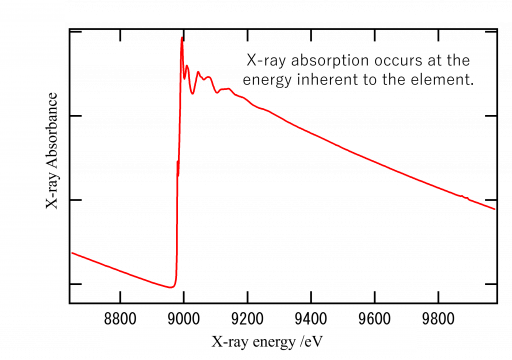
A typical XAFS spectrum of a copper compound. The horizontal axis represents X-ray energy (unit: eV), while the vertical axis represents X-ray absorption. Analyzing the sharp jump in the X-ray absorption (absorption edge) and subsequent oscillations indicate bonding with neighboring atoms.
“When I was a Ph.D. student, I would like to synthesize new catalysts and then out of necessity, I also became involved in the characterization of catalysts. I’m always interested in what synthetic researchers would like to know for their researches on material synthesis.”
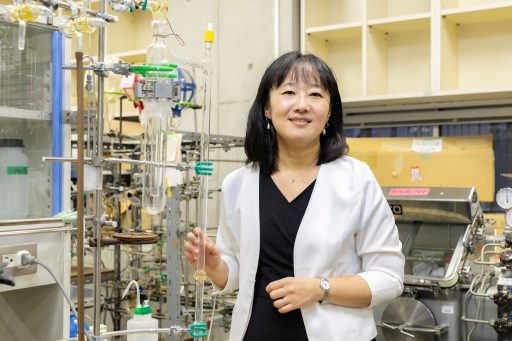
● Method to discern the individuality of catalyst
“Catalyst composed of multiple materials contains multiple structures with different activity. I thought that it was necessary to visualize the individuality of catalyst to understand real catalysis.”
Although the XAFS method has been widely developed over the past 30 years, there have been still challenges in identifying structural differences inside an individual catalyst particle because of the limitation of the X-ray beam size, which was too thick to catch a single catalyst particle. There are large distributions of catalyst particles and the location of active sites and large X-ray beam cannot tell us the individual information of the catalyst particles.
In 2008, when Dr. Tada moved to the Institute for Molecular Science, she happened upon a state-of-the-art technique for her study. The X-ray nano-beam, which was focused X-ray beam with nano size, was developed at the large synchrotron radiation facility SPring-8. She asked the collaboration using the X-ray nanobeam and brought her samples whose catalyst particles were spread on a support surface. She finally succeeded in revealing the active structure of an individual catalyst particle for the first time, using the X-ray nanobeam.
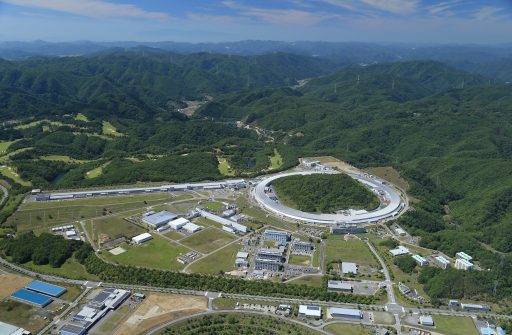
SPring-8, a large synchrotron radiation facility, located in the Harima Science Garden City in Sayo-cho, Sayo-gun, Hyogo Prefecture, Japan (Copyright: RIKEN)
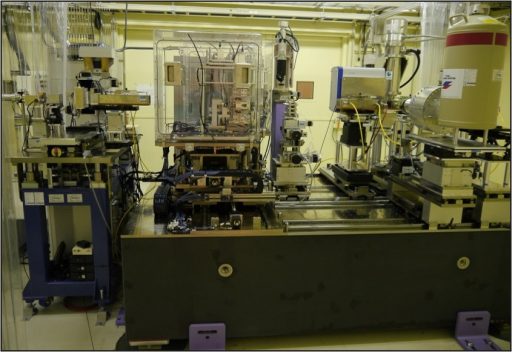
Equipment at the beamline Dr. Tada used for her experiments
●Personal drive is the criterion of research
“Practical issues at industrial frontlines will also accelerate basic research.”
While conducting advanced imaging research using the XAFS methods, she met researchers of an automobile company. She was overwhelmed by their desperate efforts to deal with various issues facing in their research and development of hydrogen-powered fuel cell vehicles. As the actual operation of fuel cell vehicles progressed, new development issues rapidly appear. However, it is not easy to look inside a fuel cell under operation. Where are degraded parts inside a fuel cell? How do they find and diagnose them rapidly? To find any hint for better understanding of the practical issues, collaborative research was proposed to Dr. Tada.
“I decide the action of my research by personal drive.”
At the time, Dr. Tada had never been involved in research about fuel cells, and she didn’t know basic research terms in the field. Nevertheless, she participated in the collaborative research without hesitation. Personal drive with eagerness and energy moves researchers and a great team conducts great research. This belief is her unwavering criterion in deciding the action of collaborative research, even to this day.
“Even with a sophisticated research theme, there will always be a big wall at difficult turning points. During such moments, the strong motivation and drive of researchers break through the difficulties to achieve the goal. Moreover, it’s essential that everyone involved shares the clear vision of the goal.”
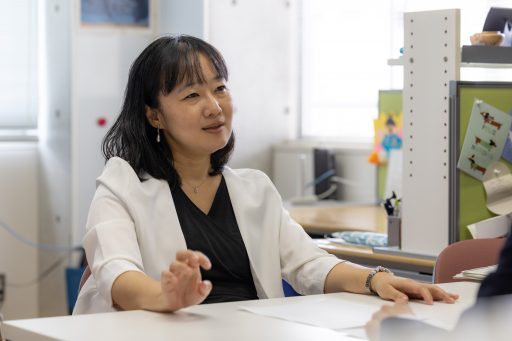
In addition, when she starts collaboration with a company, she considers that understanding of basic research is important. As long as her research is conducted at a university, obtained results are common and widely available to the public. Collaboration with a company with understanding of basic research provides the progress of research that cannot be done by university or company alone and strong relationship between academia and industry generates that allows for mutual development.
The collaborative project finally led to large-scale national research and development programs. Now, she enabled to visualize reactions and degradation in fuel cells in three dimensions using the powerful X-rays of SPring-8 and researchers in all over the world can use this method.
These researches subsequently promoted the fusion of basic research and industrial applications using synchrotron radiation. As seen in the development of the next-generation synchrotron radiation facility, NanoTerasu, scheduled to commence operation in April 2024, research using synchrotron radiation has now become a major platform attracting researchers from both academia and industries.

Next-generation synchrotron radiation facility, NanoTerasu, located at the Tohoku University Aobayama New Campus in Aoba-ku, Sendai City, Miyagi Prefecture. The energy and properties of X-rays are different from SPring-8.
● “What is the request from society?” The importance of meeting people and understanding their perspectives
Dr. Tada has been engaged in fusion research with researchers in different fields of expertise and collaborative research with various companies even now. It is impressive that she participates in extensive collaborations across diverse fields while maintaining a solid foundation in her original field of expertise.
“People who constantly keep their ear to the ground of outside fields can stay strong. Those who merely wait until the time is right within their own fields are difficult to acquire a new approach.”
Of course, there is a path of refining one’s knowledge and skills to master in the same field for 40 or 50 years. However, greatness is comparative, taking the lead among pioneers in that field is a daunting challenge. While emphasizing the importance of making efforts and building a foundation supporting one’s research within affiliated laboratory, Dr. Tada also looks outside her own field. She often recognizes surprisingly that what is common in her field is unknown elsewhere. She thinks that it is important to learn what people in other fields would like to know and what values they hold.
Dr. Tada has an anecdote from her student days, when she actively explored various adjacent fields outside her chemistry area.
“My supervisor at the time often told me that when we get older, we will tend to avoid embarrassment more so that when you are young, you should explore and present your research in different fields anyway.”
In her fourth year of university, her first academic conference was one organized by the Chemical Society of Japan, but she joined that of the organic chemistry session not of the catalytic chemistry session. “I was fearless,” she says. She later attended meetings and conferences when and wherever she was called by, such as those of the Physical Society of Japan, engineering science societies, and national or international companies. She was surprised by difference in atmosphere, with everyone wearing suits at conferences of the Chemical Society of Japan and otherwise with no one wearing formal at those of the Physical Society of Japan. Positions vary between basic and applied, and between disciplines. Even the choice of words to describe the same research in different fields is completely different.
“I met various researchers. Chemists have their own way of thinking, as do physicists, and engineers. Knowing different values will help understanding my own field strengths and weaknesses.”
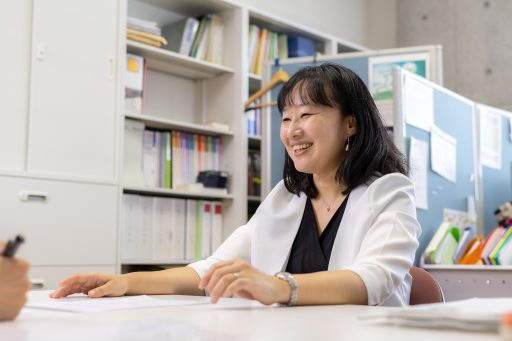
Different individuals from various backgrounds construct community, and create new values. The crux lies in how much one can understand what society currently needs.
“Always keeping antennas tuned to the outside world, maintaining a solid foundation in one’s research field of expertise while cultivating interest in diverse subjects, and not being afraid to ask questions of others and learn from them—these three elements are crucial. Surprisingly, there seem to be few people who are willing to ask others to teach them something they don’t know.”
(Interview and text by Tatsuro Ayatsuka)
